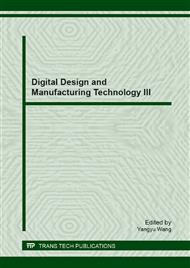p.35
p.40
p.45
p.50
p.55
p.60
p.65
p.70
p.76
Preparation and Processing Performance of Viscoelastic Abrasive Flow
Abstract:
Abstract. Abrasive flow machining (AFM) is an advanced technology which can improve the uniform consistency of profiled surface. First, the dielectric characteristics of the abrasive flow (the medium features include medium types, medium viscosity coefficient, the concentration of medium and abrasive, abrasive type, abrasive size) is studied, abrasive flow including different medium is deployed by mixing and mix well of the polymer silicone fluid, silicone oil, wax, and other fats, and adding silicon carbide with different particle size and mixed for processing experiment. Within the limits of the workpiece polishing, the change direction of the surface roughness and the removal rate of workpiece surface are substantially same and approaching the linear relationship, the lowest surface roughness Ra of SiC (abrasive particle size is 200#) reduced from 3.5μm to 0.5μm. The hardness and durability of the silicon carbide abrasive in this study is quite good, and the price is low, the processing characteristics are quite consistent with the economic costs on the demand.
Info:
Periodical:
Pages:
55-59
Citation:
Online since:
March 2013
Authors:
Keywords:
Price:
Сopyright:
© 2013 Trans Tech Publications Ltd. All Rights Reserved
Share:
Citation:


